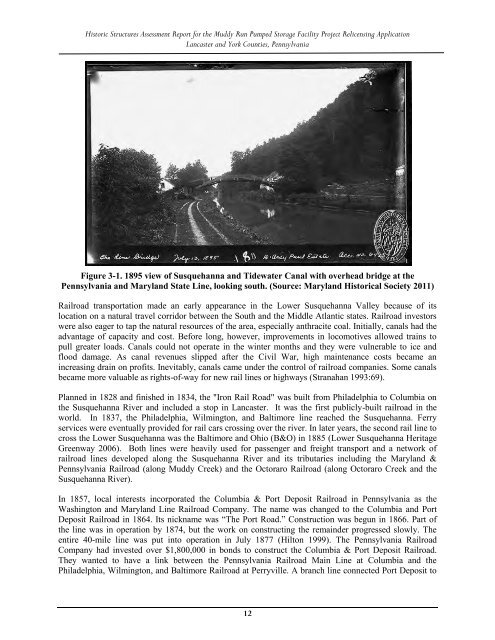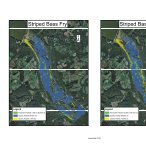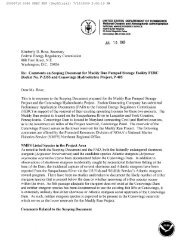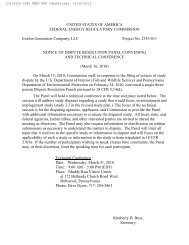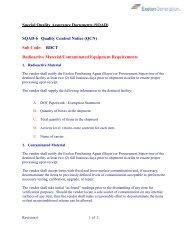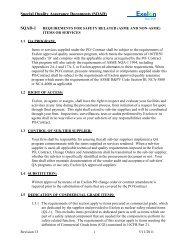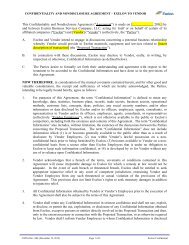Final Report Historical Structures Assessment Report for the Muddy ...
Final Report Historical Structures Assessment Report for the Muddy ...
Final Report Historical Structures Assessment Report for the Muddy ...
Create successful ePaper yourself
Turn your PDF publications into a flip-book with our unique Google optimized e-Paper software.
Historic <strong>Structures</strong> <strong>Assessment</strong> <strong>Report</strong> <strong>for</strong> <strong>the</strong> <strong>Muddy</strong> Run Pumped Storage Facility Project Relicensing Application<br />
Lancaster and York Counties, Pennsylvania<br />
Figure 3-1. 1895 view of Susquehanna and Tidewater Canal with overhead bridge at <strong>the</strong><br />
Pennsylvania and Maryland State Line, looking south. (Source: Maryland <strong>Historical</strong> Society 2011)<br />
Railroad transportation made an early appearance in <strong>the</strong> Lower Susquehanna Valley because of its<br />
location on a natural travel corridor between <strong>the</strong> South and <strong>the</strong> Middle Atlantic states. Railroad investors<br />
were also eager to tap <strong>the</strong> natural resources of <strong>the</strong> area, especially anthracite coal. Initially, canals had <strong>the</strong><br />
advantage of capacity and cost. Be<strong>for</strong>e long, however, improvements in locomotives allowed trains to<br />
pull greater loads. Canals could not operate in <strong>the</strong> winter months and <strong>the</strong>y were vulnerable to ice and<br />
flood damage. As canal revenues slipped after <strong>the</strong> Civil War, high maintenance costs became an<br />
increasing drain on profits. Inevitably, canals came under <strong>the</strong> control of railroad companies. Some canals<br />
became more valuable as rights-of-way <strong>for</strong> new rail lines or highways (Stranahan 1993:69).<br />
Planned in 1828 and finished in 1834, <strong>the</strong> "Iron Rail Road" was built from Philadelphia to Columbia on<br />
<strong>the</strong> Susquehanna River and included a stop in Lancaster. It was <strong>the</strong> first publicly-built railroad in <strong>the</strong><br />
world. In 1837, <strong>the</strong> Philadelphia, Wilmington, and Baltimore line reached <strong>the</strong> Susquehanna. Ferry<br />
services were eventually provided <strong>for</strong> rail cars crossing over <strong>the</strong> river. In later years, <strong>the</strong> second rail line to<br />
cross <strong>the</strong> Lower Susquehanna was <strong>the</strong> Baltimore and Ohio (B&O) in 1885 (Lower Susquehanna Heritage<br />
Greenway 2006). Both lines were heavily used <strong>for</strong> passenger and freight transport and a network of<br />
railroad lines developed along <strong>the</strong> Susquehanna River and its tributaries including <strong>the</strong> Maryland &<br />
Pennsylvania Railroad (along <strong>Muddy</strong> Creek) and <strong>the</strong> Octoraro Railroad (along Octoraro Creek and <strong>the</strong><br />
Susquehanna River).<br />
In 1857, local interests incorporated <strong>the</strong> Columbia & Port Deposit Railroad in Pennsylvania as <strong>the</strong><br />
Washington and Maryland Line Railroad Company. The name was changed to <strong>the</strong> Columbia and Port<br />
Deposit Railroad in 1864. Its nickname was “The Port Road.” Construction was begun in 1866. Part of<br />
<strong>the</strong> line was in operation by 1874, but <strong>the</strong> work on constructing <strong>the</strong> remainder progressed slowly. The<br />
entire 40-mile line was put into operation in July 1877 (Hilton 1999). The Pennsylvania Railroad<br />
Company had invested over $1,800,000 in bonds to construct <strong>the</strong> Columbia & Port Deposit Railroad.<br />
They wanted to have a link between <strong>the</strong> Pennsylvania Railroad Main Line at Columbia and <strong>the</strong><br />
Philadelphia, Wilmington, and Baltimore Railroad at Perryville. A branch line connected Port Deposit to<br />
12


